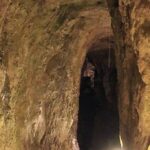
In Domokos, there's an unexplored cave called Koudounisto Pigadi (meaning 'ringing well') that nonetheless is considered an important site to visit in the area.

Crete abounds with caves, and Herakleion is no exception. From the wonderful archaeological site of the Kamares cave (see landmarks), a couple of hours north and decidedly uphill walk from the village of the same, to the famous Matala caves on the south coast and plenty betwixt and between.

Apart from the main ones listed below, there are many notable caves around Fokida, such as Agia Elousa Cave, Neraidospilia in Poludroso, Katvothra in Vargiani and others in Agoriani. Several caves are also found in Sikia. A small church has been built in one of these (Zoodochos Pigi), and the cave contains stalactites, stalagmites and a natural lake. Also noteworthy is Agia Eleoussa which was transformed into a church.

Lies at altitude of 225 meters just north of the village of Skoteino near Gouves. Findings here include votive offerings and an inscription dating back to the 4th C BC, but now thought to be fake. There is a Byzantine church close, hence the alternative name of Saint Paraskevi. Skotino means "dark".

The Eptastomos cave (meaning seven-mouthed cave) has seven openings where according to recent study is home to the southern-most glacier in Europe, some 70 meters deep!

Sometimes called Cronos Cave, this cave can be found on the Lasithi plateau, near the village of Tzermiado, at an elevation of 660 metres. Bones found within have been dated back to neolithic times (pre 3,600 BC). An narrow entrance greets the visitor into a chamber, 185 metres long, with rocks of a green hue, once inside. The broken stalagmites and stalactites was caused by human hand.

The cave of Apollo also known as Korikyo Cave in the Parnassos National Park is popular with speleologists. The cave lies on the E4 hiking trails and is about a 4-hour walk from Delphi, best approached from the church of Agia Triada. In 1969, French archaeologists discovered bone flutes, Mycenaean shards, a Neolithic male figurine, bronze and iron rings, miniature bronze statuettes and knucklebones used for foretelling (astragolomancy).

Guided tours of this stunning cave will reveal a beautifully hand-painted 11thC altar (it’s literally on the cave wall) and adjacent chambers that unveil colorful stalactites and stalagmites. Try to spot the Kythironiscus paragiamani, a creature that can only be found in this cave – it’s tiny, blind, and survives on wood and water found in the cave.

In Greek mythology, this is the spot where the great god Zeus was supposed to have been born (though some say that the more likely spot is at Petsofas on the east coast).

A little beyond the village of Proussos and near the military bridge of Kastania, you will find the gorge of Mavri Spilia. The hiking path begins with a delightful stone fountain that takes to a wooden bridge and a 10-meter-high waterfall that forms a pond. The gorge or ravine offers many areas with cascading water and ponds that are ideal for swimming, if a little on the fresh and crisp side. The fauna and flora of the area, plus a wooden bridge over the river create a fantastic scene out of a fairytale. Rappelling down the waterfalls is possible as there bolts and anchors that have been drilled into the rocks. The route ceases at the large entrance of Mavri Spilia or cave. During Ottoman domination and subsequent conflicts, the locals used to hide in the cave.
